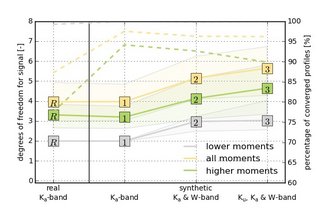During my GSGS fellowship, I finished a study I started during my PhD about the potential of higher order moments of the radar Doppler spectrum to improve radar observations of ice clouds. This is an important issue, because ice clouds play an important role for the radiation budget and the water cycle in polar regions, but only few observations are available. Traditional ice cloud measurements by radar based on lower moments of the radar Doppler spectrum typically do not contain sufficient information for an unambiguous determination of the ice cloud's properties. In the study, it is shown that the use of higher moments of the radar Doppler spectrum increases the number of independent information pieces (called degrees of freedom for signal) of radar observations significantly. As can be seen in the Figure, higher moments can provide more information than lower moments. It is found that, for a single radar frequency, more information can be retrieved when including higher moments and slopes than when using only reflectivity and mean Doppler velocity but two radar frequencies. The general feasibility of the approach can be seen by the high agreement between synthetic and real radar observations. The use of higher moments allows the retrieval of additional parameters describing microphysical properties such as the mass-size relation of ice particles, but also kinematic features such as air turbulence. The study has been submitted to the Journal of Applied Meteorology and Climatology.
Maximilian Maahn
Postdoc
“Potential of higher order moments of the radar Doppler spectrum for retrieving microphysical and kinematic properties of Arctic ice clouds”
Manuscript submitted to Journal of Applied Meteorology and Climate in Dec 2015
Institute of Geophysics and Meteorology
Supervisor: PD Dr. Ulrich Löhnert (Integrated Remote Sensing)
From March 2016 postdoc position at the “Cooperative Institute for Research in Environmental Sciences” in Boulder, CO.
